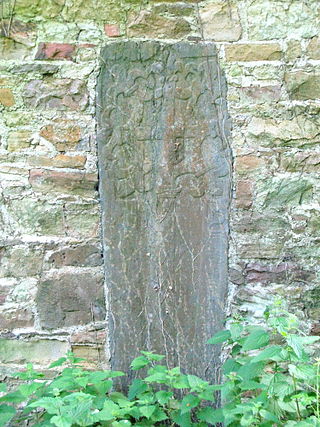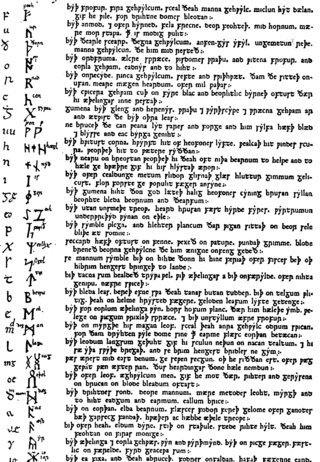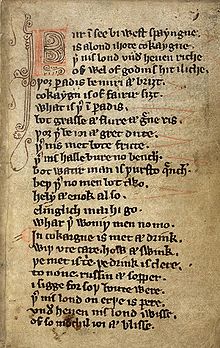
Beowulf is an Old English epic poem in the tradition of Germanic heroic legend consisting of 3,182 alliterative lines. It is one of the most important and most often translated works of Old English literature. The date of composition is a matter of contention among scholars; the only certain dating is for the manuscript, which was produced between 975 and 1025. Scholars call the anonymous author the "Beowulf poet". The story is set in pagan Scandinavia in the 6th century. Beowulf, a hero of the Geats, comes to the aid of Hrothgar, the king of the Danes, whose mead hall in Heorot has been under attack by the monster Grendel. After Beowulf slays him, Grendel's mother attacks the hall and is then defeated. Victorious, Beowulf goes home to Geatland and becomes king of the Geats. Fifty years later, Beowulf defeats a dragon, but is mortally wounded in the battle. After his death, his attendants cremate his body and erect a barrow on a headland in his memory.
Old English literature refers to poetry and prose written in Old English in early medieval England, from the 7th century to the decades after the Norman Conquest of 1066, a period often termed Anglo-Saxon England. The 7th-century work Cædmon's Hymn is often considered as the oldest surviving poem in English, as it appears in an 8th-century copy of Bede's text, the Ecclesiastical History of the English People. Poetry written in the mid 12th century represents some of the latest post-Norman examples of Old English. Adherence to the grammatical rules of Old English is largely inconsistent in 12th-century work, and by the 13th century the grammar and syntax of Old English had almost completely deteriorated, giving way to the much larger Middle English corpus of literature.

Cædmon is the earliest English poet whose name is known. A Northumbrian cowherd who cared for the animals at the double monastery of Streonæshalch during the abbacy of St. Hilda, he was originally ignorant of "the art of song" but learned to compose one night in the course of a dream, according to the 8th-century historian Bede. He later became a zealous monk and an accomplished and inspirational Christian poet.

The Junius manuscript is one of the four major codices of Old English literature. Written in the 10th century, it contains poetry dealing with Biblical subjects in Old English, the vernacular language of Anglo-Saxon England. Modern editors have determined that the manuscript is made of four poems, to which they have given the titles Genesis, Exodus, Daniel, and Christ and Satan. The identity of their author is unknown. For a long time, scholars believed them to be the work of Cædmon, accordingly calling the book the Cædmon manuscript. This theory has been discarded due to the significant differences between the poems.

Cockaigne or Cockayne is a land of plenty in medieval myth, an imaginary place of extreme luxury and ease where physical comforts and pleasures are always immediately at hand and where the harshness of medieval peasant life does not exist. Specifically, in poems like The Land of Cockaigne, it is a land of contraries, where all the restrictions of society are defied, sexual liberty is open, and food is plentiful. Writing about Cockaigne was commonplace in Goliard verse. It represented both wish fulfillment and resentment at scarcity and the strictures of asceticism.

Luke Wadding, O.F.M., was an Irish Franciscan friar and historian.
West Saxon is the term applied to the two different dialects Early West Saxon and Late West Saxon with West Saxon being one of the four distinct regional dialects of Old English. The three others were Kentish, Mercian and Northumbrian. West Saxon was the language of the kingdom of Wessex, and was the basis for successive widely used literary forms of Old English: the Early West Saxon of Alfred the Great's time, and the Late West Saxon of the late 10th and 11th centuries. Due to the Saxons' establishment as a politically dominant force in the Old English period, the West Saxon dialects became the strongest dialects in Old English manuscript writing.

The Lacnunga ('Remedies') is a collection of miscellaneous Anglo-Saxon medical texts and prayers, written mainly in Old English and Latin. The title Lacnunga, an Old English word meaning 'remedies', is not in the manuscript: it was given to the collection by its first editor, Oswald Cockayne, in the nineteenth century. It is found, following other medical texts, in London, British Library Harley MS 585, a codex probably compiled in England in the late tenth or early eleventh century. Many of its herbal remedies are also found, in variant form, in Bald's Leechbook, another Anglo-Saxon medical compendium.

Pierce the Ploughman's Crede is a medieval alliterative poem of 855 lines, lampooning the four orders of friars.
The term Middle English literature refers to the literature written in the form of the English language known as Middle English, from the late 12th century until the 1470s. During this time the Chancery Standard, a form of London-based English became widespread and the printing press regularized the language. Between the 1470s and the middle of the following century there was a transition to early Modern English. In literary terms, the characteristics of the literary works written did not change radically until the effects of the Renaissance and Reformed Christianity became more apparent in the reign of King Henry VIII. There are three main categories of Middle English literature, religious, courtly love, and Arthurian, though much of Geoffrey Chaucer's work stands outside these. Among the many religious works are those in the Katherine Group and the writings of Julian of Norwich and Richard Rolle.
My Ladye Nevells Booke is a music manuscript containing keyboard pieces by the English composer William Byrd, and, together with the Fitzwilliam Virginal Book, one of the most important collections of Renaissance keyboard music.
Nicholas Bozon, or Nicole Bozon, was an Anglo-Norman writer and Franciscan friar who spent most of his life in the East Midlands and East Anglia. He was a prolific author in prose and verse, and composed a number of hagiographies of women saints, reworkings of fables, and allegories.

Inislounaght Abbey, also referred to as Innislounaght, Inislounacht and De Surio, was a 12th-century Cistercian settlement on the river Suir, near Clonmel in County Tipperary, Ireland. It was originally dedicated to the Blessed Virgin.

The Harley Lyrics is the usual name for a collection of lyrics in Middle English, Anglo Norman, and Latin found in Harley MS 2253, a manuscript dated ca. 1340 in the British Library's Harleian Collection. The lyrics contain "both religious and secular material, in prose and verse and in a wide variety of genres." The manuscript is written in three recognisable hands: scribe A, scribe B or the Ludlow scribe, and scribe C.
William Forrest was an English Catholic priest and poet.

The Old English rune poem, dated to the 8th or 9th century, has stanzas on 29 Anglo-Saxon runes. It stands alongside younger rune poems from Scandinavia, which record the names of the 16 Younger Futhark runes.
The Fifteen Signs before Doomsday is a list, popular in the Middle Ages because of millenarianism, of the events that are supposed to occur in the fortnight before the end of the world. It may find an origin in the apocryphal Apocalypse of Thomas and is found in many post-millennial manuscripts in Latin and in the vernacular. References to it occur in a great multitude and variety of literary works, and via the Cursor Mundi it may have found its way even into the early modern period, in the works of William Shakespeare.
The so-called "For Delayed Birth" is an Old English poetic medical text found in the manuscript London, British Library, Harley 585, ff. 185r-v, in a collection of medical texts known since the nineteenth century as Lacnunga (‘remedies’). The manuscript was probably copied in the early eleventh century, though its sources may have been older.
"Ich am of Irlaunde", sometimes known as "The Irish Dancer", is a short anonymous Middle English dance-song, possibly fragmentary, dating from the early 14th century, in which an Irish woman issues an invitation to come and daunce wit me in Irlaunde. The original music for this song is now lost. It is historically important as being the earliest documented reference to Irish dance. "Ich am of Irlaunde" is well-known as the source of W. B. Yeats's poem "I Am of Ireland", and it was itself included in The Oxford Book of English Verse, The Norton Anthology of English Literature and The Longman Anthology of British Literature.










